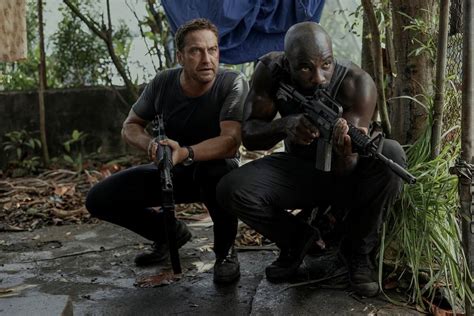
Gerard Butler’s action thriller “Plane,” initially released in theaters earlier this year, has found renewed success on Netflix, quickly climbing to the #3 spot on the streaming platform’s charts. The film, which sees Butler portraying a pilot caught in a life-or-death situation after a lightning strike forces an emergency landing in hostile territory, is experiencing a resurgence in viewership, proving its enduring appeal to action movie fans.
“Plane,” directed by Jean-François Richet, stars Butler as Brodie Torrance, a commercial pilot who must work with a convicted murderer, Louis Gaspare (Mike Colter), to protect his passengers from dangerous rebels after their plane crash-lands on a war-torn island in the Philippines. The film’s unexpected Netflix success underscores the continued demand for high-octane action movies with a charismatic leading man.
The film’s plot centers around a harrowing flight from Singapore to Tokyo on New Year’s Eve, where a severe storm forces Captain Torrance to make a risky emergency landing. The remote island turns out to be controlled by armed separatists, who take the surviving passengers hostage. Torrance, along with Gaspare, an accused murderer being extradited to Canada, must team up to rescue the passengers and find a way off the island.
“Plane” received mixed reviews upon its theatrical release in January 2023, but it was generally praised for its straightforward action sequences and Butler’s performance. According to Yahoo Entertainment, the film has resonated with Netflix viewers, likely due to its easily accessible, high-stakes narrative. The movie’s availability on a widely-used streaming service has allowed it to reach a broader audience, contributing to its newfound popularity.
The critical consensus highlights the film’s strengths as a no-frills action vehicle. While some critics found the plot predictable, many acknowledged that “Plane” delivers exactly what it promises: intense action, suspense, and a compelling lead performance from Butler. The supporting cast, particularly Mike Colter, also garnered praise for their contributions to the film’s overall dynamic.
The success of “Plane” on Netflix is also indicative of the broader trend of action movies performing well on streaming platforms. The convenience of watching movies at home, coupled with the genre’s broad appeal, makes action thrillers a popular choice for viewers looking for an engaging and entertaining experience. Gerard Butler, known for his roles in action-packed films like “300” and the “Has Fallen” series, has cultivated a strong following within the genre, further boosting the film’s appeal.
The film was produced with a budget of approximately $25 million and grossed over $52 million worldwide in theaters, making it a modest box office success before its recent streaming resurgence. The financial performance underscores the potential for action films to find success both in theaters and on streaming platforms, catering to different viewing preferences.
The renewed interest in “Plane” also coincides with a broader conversation about the role of streaming services in shaping movie viewership. Netflix, with its extensive subscriber base and algorithmic recommendations, has the power to significantly impact a film’s reach and visibility. The platform’s ability to highlight older movies or films that may have been overlooked in theaters can lead to unexpected successes, as seen with “Plane.”
The impact of “Plane” extends beyond mere viewership numbers. The film’s success on Netflix has sparked discussions about the criteria for a successful movie in the modern entertainment landscape. While theatrical box office numbers remain an important metric, streaming performance is increasingly recognized as a key indicator of a film’s overall popularity and cultural impact. The ease of access provided by streaming services allows films to find new audiences and extend their lifespan, potentially leading to long-term recognition and appreciation.
Moreover, the success of “Plane” can be attributed to several factors, including its timing, genre, and star power. The film’s release on Netflix coincided with a period when viewers were actively seeking escapist entertainment. The action genre, known for its thrilling narratives and visual spectacle, offers a welcome distraction from real-world concerns. Gerard Butler’s presence as the lead actor adds to the film’s appeal, drawing in fans who appreciate his signature style and commitment to action roles.
The production of “Plane” faced several challenges, including logistical hurdles related to filming in remote locations. The film was shot primarily in Puerto Rico, which offered a diverse range of landscapes that could convincingly depict the war-torn island setting. The filmmakers had to navigate complex permitting processes and ensure the safety of the cast and crew while working in challenging environments. Despite these obstacles, the production team successfully created a visually compelling and immersive cinematic experience.
The marketing campaign for “Plane” emphasized the film’s high-stakes action and suspenseful plot. The trailers and promotional materials highlighted the plane crash, the hostage situation, and the desperate efforts of Captain Torrance and Louis Gaspare to save the passengers. The marketing team also leveraged Gerard Butler’s star power, showcasing his role as the determined and resourceful pilot. The campaign successfully generated awareness and excitement for the film, contributing to its initial theatrical release and subsequent streaming success.
The thematic elements explored in “Plane” include themes of survival, redemption, and unlikely alliances. Captain Torrance must overcome his own fears and limitations to protect the passengers and find a way off the island. Louis Gaspare, despite his criminal past, proves to be a valuable ally, demonstrating his skills and resourcefulness in the face of danger. The film suggests that even in the most dire circumstances, individuals can find common ground and work together to achieve a shared goal.
The visual effects in “Plane” play a crucial role in enhancing the film’s realism and impact. The plane crash sequence, in particular, is a visually stunning and harrowing depiction of the disaster. The visual effects team meticulously recreated the experience of a plane being struck by lightning and forced to make an emergency landing, creating a sense of immersion and intensity for the audience. The film’s use of visual effects is seamless and effective, adding to the overall cinematic experience.
The sound design in “Plane” is equally important in creating a sense of tension and atmosphere. The sound of the crashing plane, the gunfire, and the jungle ambiance all contribute to the film’s immersive qualities. The sound designers carefully crafted the audio landscape to heighten the audience’s emotional response and create a sense of urgency and danger. The film’s sound design is a key element in its overall success.
The cultural impact of “Plane” extends beyond its commercial performance. The film has sparked conversations about the portrayal of violence and heroism in action movies. Some critics have questioned the film’s depiction of the armed separatists and the use of violence as a means of resolving conflict. Others have praised the film for its escapist entertainment value and its celebration of individual courage and resilience. The film’s cultural impact is multifaceted and continues to be debated among viewers and critics alike.
The success of “Plane” on Netflix has prompted discussions about the future of action movies in the streaming era. Streaming services are increasingly becoming a dominant force in the entertainment industry, providing a platform for a wide range of films and television shows. Action movies, with their broad appeal and high entertainment value, are well-suited for the streaming format. As streaming services continue to invest in original content and acquire existing films, the future of action movies looks bright.
The film’s director, Jean-François Richet, brought his experience directing action films like “Assault on Precinct 13” (2005) and “Blood Father” (2016) to “Plane.” Richet’s direction emphasizes the practical effects and stunts, giving the film a gritty and realistic feel. He focuses on the characters’ reactions to the extreme situations they face, creating a sense of tension and suspense that keeps the audience engaged.
Mike Colter, who plays Louis Gaspare, provides a compelling performance as the accused murderer who becomes an unlikely ally. Colter, known for his role as Luke Cage in the Marvel Netflix series, brings a physicality and intensity to the role, making Gaspare a formidable presence. His character arc, from a feared criminal to a trusted partner, adds depth and complexity to the film’s narrative.
The screenplay for “Plane” was written by Charles Cumming and J.P. Davis, based on a story by Cumming. The writers crafted a tight and suspenseful plot that keeps the audience guessing. They effectively develop the characters of Torrance and Gaspare, giving them clear motivations and believable interactions. The screenplay balances the action sequences with moments of character development, creating a well-rounded and engaging story.
The cinematography in “Plane” is notable for its use of wide shots and dynamic camera angles. The cinematographers capture the vastness of the jungle and the claustrophobia of the airplane cabin, creating a visually compelling experience. They also utilize close-ups to emphasize the characters’ emotions and reactions, drawing the audience into the story.
The editing in “Plane” is fast-paced and energetic, mirroring the film’s action-packed narrative. The editors effectively cut between the different storylines and perspectives, creating a sense of urgency and momentum. They also use slow-motion and other editing techniques to highlight key moments of action and suspense.
The music in “Plane” is composed by Marco Beltrami and Marcus Trumpp. The score is characterized by its driving rhythms and dramatic melodies, enhancing the film’s tension and excitement. The music effectively underscores the emotional beats of the story, adding depth and impact to the scenes.
The special effects in “Plane” are seamlessly integrated into the film, enhancing the realism of the action sequences. The visual effects team meticulously recreated the plane crash and the jungle environment, creating a believable and immersive world for the audience. The special effects are used sparingly but effectively, adding to the film’s overall impact.
The film’s distribution was handled by Lionsgate in theaters and subsequently by Netflix for streaming. This distribution strategy allowed the film to reach a wide audience through both traditional and digital channels. The success of “Plane” on Netflix demonstrates the growing importance of streaming platforms in the distribution and consumption of movies.
The critical reception of “Plane” was mixed, with some critics praising its action sequences and performances, while others found its plot predictable. However, the film’s commercial success, both in theaters and on Netflix, suggests that it resonated with a broad audience. The film’s ability to deliver on its promise of high-octane action and suspense contributed to its positive reception among viewers.
The long-term impact of “Plane” remains to be seen, but its success on Netflix suggests that it could become a cult classic among action movie fans. The film’s memorable characters, thrilling plot, and impressive action sequences could help it stand the test of time. Its availability on streaming platforms ensures that it will continue to be discovered and enjoyed by new audiences for years to come.
The film’s depiction of the Philippines, while fictionalized, has sparked some discussion about representation and cultural sensitivity. While the film is not intended to be a documentary, some viewers have raised concerns about the portrayal of the local population and the accuracy of the setting. These discussions highlight the importance of responsible storytelling and the need for filmmakers to be mindful of the cultural impact of their work.
The overall success of “Plane” can be attributed to a combination of factors, including its compelling plot, strong performances, impressive action sequences, and effective distribution strategy. The film’s ability to deliver on its promise of high-octane entertainment made it a hit with audiences, both in theaters and on Netflix. Its success underscores the enduring appeal of action movies and the growing importance of streaming platforms in the entertainment industry.
Gerard Butler’s performance in “Plane” has been praised for its physicality and intensity. He brings a sense of determination and vulnerability to the role of Captain Torrance, making him a relatable and sympathetic character. His ability to handle both the action sequences and the emotional moments of the film contributed to its overall success.
The film’s exploration of themes such as survival, redemption, and unlikely alliances resonates with audiences on a deeper level. The characters are forced to confront their own fears and limitations in the face of extreme circumstances, and they ultimately find strength in working together. These themes add depth and meaning to the film, making it more than just a simple action movie.
The visual effects in “Plane” are used to enhance the realism and impact of the action sequences. The plane crash, in particular, is a visually stunning and harrowing depiction of the disaster. The effects are seamlessly integrated into the film, creating a believable and immersive world for the audience.
The sound design in “Plane” is equally important in creating a sense of tension and atmosphere. The sound of the crashing plane, the gunfire, and the jungle ambiance all contribute to the film’s immersive qualities. The sound designers carefully crafted the audio landscape to heighten the audience’s emotional response and create a sense of urgency and danger.
The cinematography in “Plane” is notable for its use of wide shots and dynamic camera angles. The cinematographers capture the vastness of the jungle and the claustrophobia of the airplane cabin, creating a visually compelling experience. They also utilize close-ups to emphasize the characters’ emotions and reactions, drawing the audience into the story.
The editing in “Plane” is fast-paced and energetic, mirroring the film’s action-packed narrative. The editors effectively cut between the different storylines and perspectives, creating a sense of urgency and momentum. They also use slow-motion and other editing techniques to highlight key moments of action and suspense.
The music in “Plane” is composed by Marco Beltrami and Marcus Trumpp. The score is characterized by its driving rhythms and dramatic melodies, enhancing the film’s tension and excitement. The music effectively underscores the emotional beats of the story, adding depth and impact to the scenes.
The special effects in “Plane” are seamlessly integrated into the film, enhancing the realism of the action sequences. The visual effects team meticulously recreated the plane crash and the jungle environment, creating a believable and immersive world for the audience. The special effects are used sparingly but effectively, adding to the film’s overall impact.
The film’s success on Netflix highlights the growing importance of streaming platforms in the entertainment industry. Netflix has a vast subscriber base and a sophisticated recommendation algorithm, which allows it to reach a wide audience and promote films that might otherwise be overlooked. The success of “Plane” on Netflix demonstrates the platform’s power to revitalize older films and introduce them to new viewers.
The overall success of “Plane” can be attributed to a combination of factors, including its compelling plot, strong performances, impressive action sequences, and effective distribution strategy. The film’s ability to deliver on its promise of high-octane entertainment made it a hit with audiences, both in theaters and on Netflix. Its success underscores the enduring appeal of action movies and the growing importance of streaming platforms in the entertainment industry.
Frequently Asked Questions (FAQ)
1. What is “Plane” about?
“Plane” is an action thriller starring Gerard Butler as Captain Brodie Torrance, a pilot who crash-lands his plane on a war-torn island in the Philippines after being struck by lightning. He must then team up with Louis Gaspare (Mike Colter), an accused murderer being extradited, to protect his passengers from dangerous rebels and find a way off the island.
2. Where can I watch “Plane”?
“Plane” was initially released in theaters and is now available for streaming on Netflix.
3. What kind of reviews did “Plane” receive?
“Plane” received mixed reviews upon its theatrical release. While some critics found the plot predictable, many praised the film for its straightforward action sequences and Butler’s performance.
4. What is Gerard Butler known for?
Gerard Butler is known for his roles in action-packed films like “300,” the “Has Fallen” series (e.g., “Olympus Has Fallen,” “London Has Fallen,” “Angel Has Fallen”), and “Law Abiding Citizen.”
5. How well did “Plane” do at the box office before streaming?
“Plane” had a budget of approximately $25 million and grossed over $52 million worldwide in theaters, making it a modest box office success before its resurgence on Netflix.









